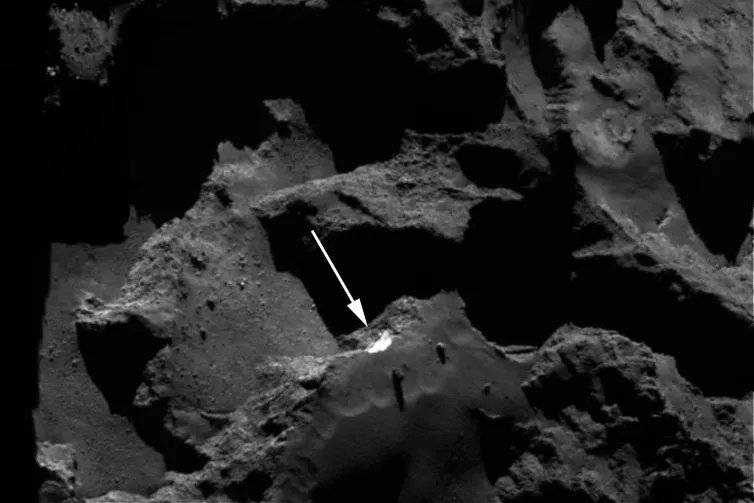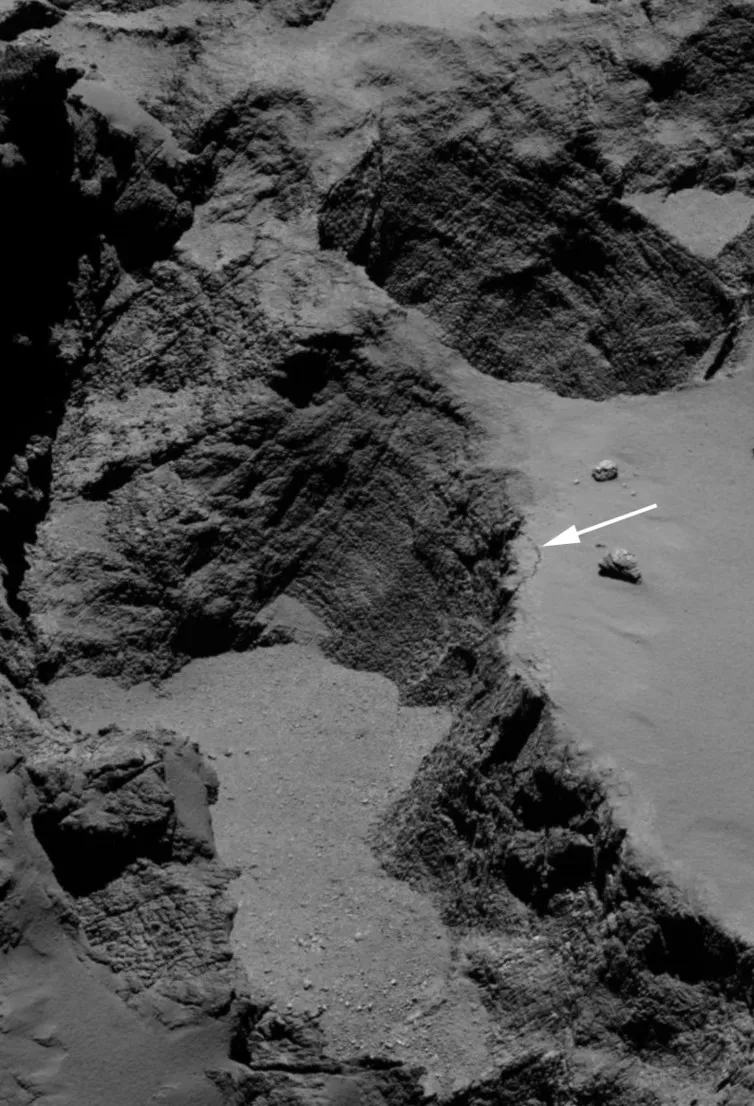It is almost six months since the Rosetta spacecraft completed its operations in a controlled dive onto the surface of comet 67P/Churyumov-Gerasimanko. The landing, after which Rosetta could no longer communicate with Earth, may have marked the end of data collection from the comet – but not the end of news about 67P. The archive of information amassed during the mission will be a rich source of material for many years. In fact, the data interpretation phase of the mission has barely begun.
Now two new studies report that Rosetta managed to capture both fracturing of its surface and a landslide which triggered a major outburst of dust on the comet – an event which revealed its pristine interior.
One of the most exciting and intriguing findings of the Rosetta mission was the landscape of 67P. After the humour of the images taken by the navigation camera (NavCam) in July 2014 showing the nucleus to be “duck-shaped”, the scenery of the comet’s surface became increasingly fascinating as the spacecraft moved closer towards the comet. The landscape of rocky cliffs and valleys, boulder-strewn plains and deep rifts was a surprise to many observers. Where were the ice fields and crevasses that might be expected on a body that was assumed to be predominantly composed of ice.

The model of a comet as a “dirty snowball” had long since been replaced by the idea of an “icy dirtball”. But high-resolution images of 67P taken by Rosetta’s OSIRIS image system revealed very little ice, and a lot of rock. Ice was certainly present, and some of the most iconic pictures of 67P show the nucleus silhouetted against a backdrop of jets and plumes of dust escaping from the surface. Scientists assumed that ice vaporised from the surface through a process called sublimation, triggered by exposure to sunlight, which led to the collapse of fractures and outbursts of dust and volatile substances.
Violent season
In the two new studies researchers have started to explore the way in which the topography of 67P changes as it draws closer to, then moves away from, the sun. And what they have found is more varied than anyone probably imagined, given that the main agent of erosion and change is simply sunlight.
One of the studies, published in Science, takes a detailed view of parts of the northern hemisphere down to equatorial regions. The propagation of fractures is clearly an important mechanism for altering the landscape: one particular fault line in the “neck” region of the comet – initially 500 metres long – grew by at least 50 metres, possibly up to 150 metres, over a six month period. The authors suggest that the fracturing was caused by activity in 67P’s nucleus in response to the heat from the sun, leading to a torque-induced increase in the comet’s spin rate. This change, in turn, resulted in stress that produced the fracturing.
Fracturing exposes fresh material in the comet’s interior to sunlight, which generates increased activity as some of this material sublimes. The mechanism ultimately should, presumably, result in the comet breaking up. However, as the comet moved away from the sun, activity died down. But there do not appear to be any reports of fractures healing – so 67P might “self-destruct” on one of its future trips close to the sun. It orbits relatively often: every 6.45 years.

Rather than fractures, another paper, published in Nature Astronomy, focuses on crumbling cliffs. Images taken by the NavCam following a particularly large outburst of gas and dust in July 2015 traced the plume back to the Aswan region. A few days later, the OSIRIS system captured detailed images of a steep slope in the region that reflected more sunlight than the surrounding regions. The authors refer to this as a “fresh, sharp and bright edge” on the Aswan cliff, which had clearly been formed by a landslide following the collapse of part of the cliff.
The bright edge was due to ice normally hidden in the comet’s interior becoming exposed – which reflected more sunlight. A further set of images taken five months later showed that the brightness had returned to 67P’s normal value, signalling that the ice had evaporated, and the cliff was again covered in dust. The observation is particularly important as it is the first recorded association of an outburst of activity with a specific feature.
The two papers have led to a better understanding of the range of mechanisms that are shaping the comet’s surface today. But, as the Science paper concludes, these are very superficial changes which can be observed to wax and wane as the comet turns through its seasons. What were the processes that produced the fault lines and cliffs in the first place? Collisions? Enhanced activity resulting from a greater volatile content? It is not clear.
We’ll just have to go to another comet to find out.
Monica Grady, Professor of Planetary and Space Sciences, The Open University
This article was originally published on The Conversation. Read the original article.
Follow Science Focus onTwitter,Facebook, Instagramand Flipboard